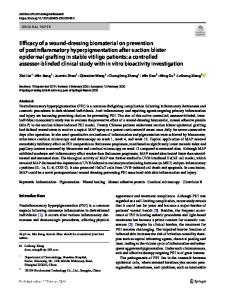Glucomannan asymmetric membranes for wound dressing
- PDF / 536,708 Bytes
- 9 Pages / 584.957 x 782.986 pts Page_size
- 8 Downloads / 362 Views
Glucomannan asymmetric membranes for wound dressing Giovana Maria Genevro1,b), Reginaldo Jose Gomes Neto1,b), Marisa Masumi Beppu1,a), Mariana Agostini de Moraes2 , Letícia de Almeida Paulo3, Patrícia Santos Lopes3 1
School of Chemical Engineering, Department of Materials and Bioprocess Engineering, University of Campinas, Campinas, SP 13083-852, Brazil Environmental, Chemical and Pharmaceutical Sciences Institute, Department of Chemical Engineering, Universidade Federal de São Paulo, Diadema, SP 09913-030, Brazil 3 Environmental, Chemical and Pharmaceutical Sciences Institute, Department of Pharmaceutical Sciences, Universidade Federal de São Paulo, Diadema, SP 09913-030, Brazil a) Address all correspondence to this author. e-mail: [email protected] b) These authors contributed equally to this work. 2
Received: 24 June 2018; accepted: 20 November 2018
Asymmetric membranes present promising characteristics for wound dressing applications. A porous structure uptakes the wound exudate, whereas an occlusive layer (upper film) inhibits the microbial penetration and prevents an excessive loss of water. Konjac glucomannan (KGM) is a natural polysaccharide that has been investigated as wound dressings in the form of films, sponges, and hydrogels due to its flexibility, swelling capacity, biocompatibility, and low cost. However, there are no studies on literature regarding the development of KGM asymmetric membranes. In this study, we investigated a new casting–freezing process for the production of KGM asymmetric membranes. The scanning electron microscopy and thermogravimetric analyses indicated an asymmetric morphology and a good thermal stability of the membrane samples, respectively. Moreover, biological, mechanical, and fluid-handling capacity tests showed that the membrane is biocompatible and resistant to handling structure, which was also able to retain the ideal moist conditions for wound healing.
Introduction The skin is the largest organ in the human body and acts as a primary barrier against infectious agents. Also, it is responsible for regulating the body temperature, preventing the loss of body fluids, and storing a large number of nerve endings [1]. More than 20 million patients suffer from chronic skin injuries worldwide and the healing process for those injuries are usually slow, expansive, and poorly effective [2, 3]. In this context, many efforts have been made to aim the development of new wound dressings that could promote a rapid healing and minimize the patient pain [4]. An ideal wound dressing should be able to absorb the wound exudates, protect the wound injuries from secondary infections, provide adequate gaseous exchanges, and regulate the release of growth factors and cytokines. Furthermore, it should be elastic, biocompatible, resistant to handling, nontoxic, and nonantigenic [5]. Among the desired characteristics of a high-performance wound dressing, the maintenance of an optimal moisture environment plays a key role in the wound
ª Materials Research Society 2019
healing process [6]. A s
Data Loading...











